Click on images to enlarge
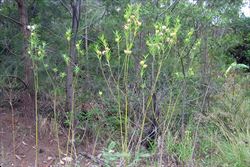
few-branched habit (Photo: Mellisa Offord)
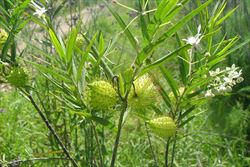
habit (Photo: Sheldon Navie)
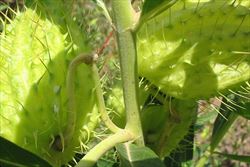
close-up of finely hairy stems and s-shaped fruit stalk (Photo: Sheldon Navie)
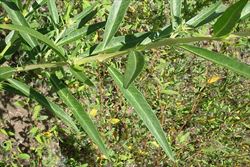
elongated leaves (Photo: Sheldon Navie)

flower clusters (Photo: Sheldon Navie)
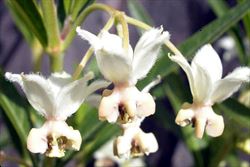
close-up of flowers (Photo: Greg Jordan)
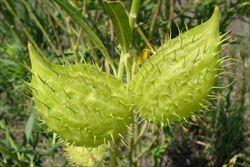
immature fruit (Photo: Sheldon Navie)
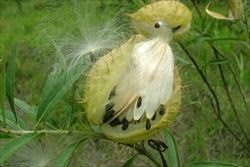
mature fruit beginning to release its seeds (Photo: Sheldon Navie)
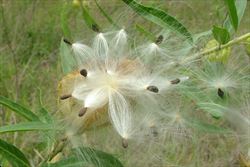
seeds (Photo: Sheldon Navie)
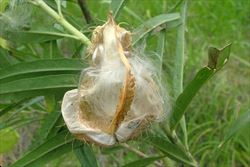
mature fruit having released most of its seeds (Photo: Sheldon Navie)
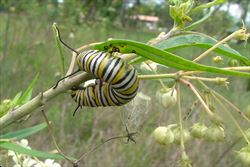
narrow-leaved cotton bush (Gomphocarpus fruticosus) is the preferred food plant of the caterpillar of the wanderer butterfly, Danaus plexippus (Photo: Sheldon Navie)
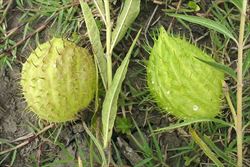
comparison of the fruit of balloon cotton bush (Gomphocarpus physocarpus), on the left, and narrow-leaved cotton bush (Gomphocarpus fruticosus), on the right (Photo: Sheldon Navie)
Scientific Name
Gomphocarpus fruticosus (L.) W.T. Aiton
Synonyms
Asclepias fruticosa L.Gomphocarpus fruticosus (L.) R. Br.Gomphocarpus fruticosus (L.) W.T. Aiton subsp. fruticosus
Family
Asclepiadaceae (Victoria, the ACT, Tasmania, South Australia, Western Australia and the Northern Territory)Apocynaceae (Queensland and New South Wales)
Common Names
arghel, arghel of Syria, balloon cotton, balloon cotton bush, Cape cotton, narrow leaf cotton bush, duck bush, duckbush, milk weed, milkweed, narrow-leaf cotton bush, narrowleaf cotton bush, narrow-leaf cottonbush, narrowleaf cottonbush, narrow-leaved cotton bush, narrowleaved cotton-bush, swan bush, swan plant, swanplant, wild cotton
Origin
Native to southern and eastern Africa (i.e. South Africa, Lesotho, Swaziland, Namibia, southern Angola, Botswana, Zambia, Zimbabwe, Malawi, Mozambique, Tanzania, Kenya, Ethiopia, Somalia and Eritrea) and the southern parts of the Arabian Peninsula (i.e. Oman, Yemen and the southern parts of Saudi Arabia).
There are several subspecies, and the one that is thought to be widely naturalised in Australia and in other parts of the world has a more limited distribution in southern Africa (i.e. in southern Angola, Namibia, South Africa, Swaziland, Lesotho, Malawi, Zambia, Zimbabwe, Mozambique and Botswana).
Cultivation
Narrow-leaved cotton bush (Gomphocarpus fruticosus) may have occasionally been grown in gardens in the past, but it is seldom deliberately cultivated these days. However, its unusual fruit are sometimes still used in flower arrangements.
Naturalised Distribution
Widely naturalised in Australia with a scattered distribution throughout the southern and eastern parts of the country. It is most common in south-western Western Australia and the coastal and sub-coastal regions of eastern New South Wales. Also present in many parts of South Australia, in western and central Victoria, in Tasmania, in the inland parts of southern New South Wales and in south-eastern Queensland.
Also naturalised overseas in many other parts of the world (e.g. New Zealand, the Azores, India and Mauritius).
Habitat
This species grows in a wide range of environments including warm temperate, sub-tropical, tropical and occasionally even semi-arid regions. It is a weed of roadsides, disturbed sites, waste areas, waterways, pastures, open woodlands and fallows.
Habit
An upright (i.e. erect) shrubby plant usually growing 0.5-2 m tall. It is a relatively long-lived (i.e. perennial) species and normally has a rather slender few-branched habit.
Distinguishing Features
- a small, upright, long-lived shrub usually growing 0.5-2 m tall that is rather slender and few-branched.
- its stems and leaves contain a poisonous milky sap.
- its leaves are narrow (5-12.5 cm long and 5-15 mm wide) and oppositely arranged along the stems.
- its flowers (12-13 mm across) are white or cream in colour with five waxy petals and a crown-like structure at its centre.
- its distinctive, inflated fruit (4-6 cm long and 2-3.5 cm wide) are slightly curved, covered in soft bristles, and gradually taper to a short point at their tips.
- these fruit contain numerous seeds topped with silky white hairs (about 30 mm long).
Stems and Leaves
The upright (i.e. erect) stems are pale green in colour and covered in small whitish hairs (i.e. hoary) when young. These stems turn brown in colour and become somewhat woody with age. All parts of the plant, and particularly the stems, exude a white milky sap (i.e. latex) when broken or damaged.
The leaves are rather narrow or elongated (i.e. linear-lanceolate) in shape and taper to a point at both ends (i.e. with attenuate bases and acute apices). These leaves (4-12.5 cm long and 5-15 mm wide) are oppositely arranged along the stems and borne on short stalks (i.e. petioles) 3-10 mm long. Their upper surfaces are usually shiny and pale green in colour while their lower surfaces are paler and duller in appearance.
Flowers and Fruit
The flowers are borne in loose, drooping (i.e. pendulous) clusters (i.e. umbels) in the forks (i.e. axils) of the leaves. These clusters consist of 3-10 flowers, each flower being borne on a slender stalk (i.e. pedicel) 10-20 mm long, and the flower stalks (i.e. pedicels) all radiate from the same point. The flowers (about 2 cm long and 12-13 mm across) are white or cream coloured (sometimes with slightly pinkish centres) and are slightly tubular in appearance. They have five waxy petals that are used together at the base with lobes (i.e. corolla lobes) 6-7 mm long. In the centre of these flowers are five pouch-like projections that form a distinctive crown-like structure (i.e. corona). The flowers also have five small and narrow sepals and five stamens. Flowering occurs from spring through until early autumn (i.e. from August to April), but is most abundant during summer.
The distinctive thin-walled fruit are balloon-like or bladdery in appearance (4-7 cm long and 1.5-3.5 cm wide) and light green in colour. Often referred to as 'pods', they are actually follicles, and are borne on an S-shaped stalk (i.e. pedicel). These fruit are narrowly egg-shaped (i.e. narrowly ovoid), slightly curved (i.e. falcate), and covered in soft spines or bristles up to 10 mm long. They gradually taper to a short pointed projection (i.e. beak) at one end, turn brown in colour with age, and split open at maturity to release their numerous seeds. These seeds (about 6 mm long and 3 mm wide) are brown or black in colour, flattened, and topped with a tuft (i.e. coma) of numerous white silky hairs (about 30 mm long). The fruit are present from late summer through to late spring (i.e. from February to December).
Reproduction and Dispersal
This species reproduces by seed and suckers may also be produced off lateral roots that are closest to the soil surface.
The seeds are most commonly spread by wind and water. They may also be dispersed as a contaminant of agricultural produce (e.g. fodder) or in mud attached to animals, machinery and other vehicles.
Environmental Impact
Narrow-leaved cotton bush (Gomphocarpus fruticosus) is regarded as an environmental weed in Western Australia, New South Wales, Tasmania, Victoria and Queensland. It was recently listed as a priority environmental weed in two Natural Resource Management regions. This species is currently of most concern in New South Wales and Western Australia. It is a common weed of grasslands, open woodlands and disturbed sites in these states and also invades vegetation near waterways and around other waterbodies (i.e. riparian areas). It competes with native plants in these habitats and is capable of forming dense thickets.
In Western Australia narrow-leaved cotton bush (Gomphocarpus fruticosus) is most prevalent on the Darling Scarp and the Swan Coastal Plain between Perth and Bunbury, though it may also be found as far south as Albany and as far east as Esperance. It is also found occasionally inland in the wheatbelt region. This species was listed as a moderately important species in the Environmental Weed Strategy of Western Australia and has also been recorded in several conservation areas in this state (e.g. Lake McLarty Nature Reserve and Beeliar Regional Park).
Narrow-leaved cotton bush (Gomphocarpus fruticosus) is also present in conservation areas in New South Wales (e.g. Hortons Creek Nature Reserve, Theo Tulk Reserve and Byrnes Scrub Nature Reserve) and appears on several regional environmental weed lists (e.g. for the wider Sydney and Blue Mountains and South Coast regions). It usually grows along forest margins or grassy remnant native vegetation in New South Wales, but has also been reported from coastal environs. In the Namoi catchment, in the inland parts of northern New South Wales, it is also listed among the top 20 priority environmental weed species. It is also a common weeds of endangered brogo wet vine forest and dry rainforest ecological communities in the south-eastern corner of New South Wales. Narrow-leaved cotton bush (Gomphocarpus fruticosus) is also listed as a common environmental weed of the Adelaide region in South Australia.
Other Impacts
Narrow-leaved cotton bush (Gomphocarpus fruticosus) is poisonous to livestock and humans, and has caused deaths in cattle, sheep and poultry. It is seldom consumed fresh by livestock, but may be dangerous if it contaminates fodder or chaff. Severe gastroenteritis is the main symptom of poisoning by this species. Dense infestations may also reduce the productivity of pastures.
Legislation
This species is declared under legislation in the following states and territories:
- Western Australia: P1 - the movement of this species or its seeds is prohibited (throughout the entire state), P3 - a weed which cannot be eradicated in the short term, but must be kept under 'control' (in some local authority areas), and P4 - it must be 'contained' (in large parts of the state). See the Western Australian Department of Agriculture and Food Declared Plant List at http://www.agric.wa.gov.au/ for more detailed information about which areas are covered by these declarations.
Management
For information on the management of this species see the following resources:
- the Western Australian Department of Agriculture and Food Farmnote on this species, which is available online at http://www.agric.wa.gov.au.
Similar Species
Narrow-leaved cotton bush (Gomphocarpus fruticosus) is very similar to balloon cotton bush (Gomphocarpus physocarpus). These two species can be distinguished by the following differences:
- narrow-leaved cotton bush (Gomphocarpus fruticosus) has narrowly egg-shaped (i.e. ovoid) and slightly curved (i.e. falcate) fruit that gradually taper to a short, curved beak.
- balloon cotton bush (Gomphocarpus physocarpus) has rounded (i.e. globose or sub-globose) fruit that come to an abrupt point and often have a sunken (i.e. indented) tip with a tiny beak.
These two species often grow together and readily hybridise, eventually producing hybrid swarms. These hybrid swarms consist of plants that gradually intergrade between to two species, sometimes making it impossible to assign individual plants to a particular species.

